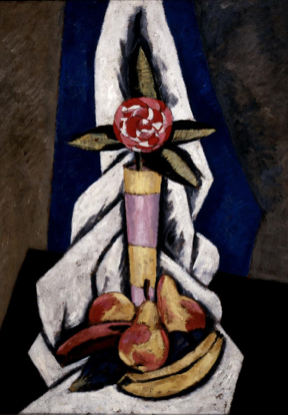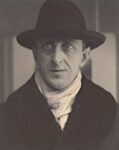
Marsden Hartley
American, 1877-1943
Still Life, 1929-1930
oil on cardboard
23.75 x 18.75 in.
SBMA, Gift of Wright S. Ludington
1950.3

Alfred Stieglitz, "Marsden Hartley", 1916, platinum print, National Gallery of Art, Washington, DC
“It is never difficult to see images – when the principle of the image is embedded in the soul.” - Marsden Hartley
RESEARCH PAPER
Marsden Hartley was born in Lewiston, Maine, the son of poor immigrants. His mother died when he was eight years of age after which he considered himself a "lone, lost thing" and lived a childhood "vast with terror and surprise". He was chronically poor and remained so for most of his life. He became a mystic, attracted to the transcendentalist painter Albert Pinkham Ryder as well as to the writings of Emerson.
At twenty-two, he studied with the American Impressionist, William Merritt Chase, in New York. He later joined the circle of "avante garde" painters who gathered around Alfred Stieglitz. With financial help from Stieglitz, he went to Paris in 1912. There he studied the works of Picasso, Matisse and the Primitives. He was considered a gifted poet and essayist and was a regular at the Salon of Gertrude Stein. His Cubist paintings were in the Armory Show.
He absorbed much of the modern techniques of painting in France but his first great moment came in Germany in 1913. His heart was with the Blaue Reiter group in Munich. He exhibited with Kandinsky, Marc and others with a series of vibrant, expressionist abstract paintings in Berlin. He was attracted to the city's homosexual subculture, fell in love with a German cavalry officer (who was later killed), and relished the hoopla of bands, parades and uniforms. World War I forced him to leave Germany and return to New York where his German paintings were rejected. He became an itinerant, trying to find a way to start again. He spent time in Provincetown, Mass., Maine, New Mexico and Bermuda.
He returned to Europe in the 1920's and spent the decade in Germany, Paris and southern France with intermittent trips home. He was supported in part by a stipend in exchange for paintings by an American Syndicate of businessmen. He studied Cezanne devotedly during 1925-1929, and read the philosophies of the European metaphysicists in depth. It was a grueling, sad search for a style of his own. He was intrigued with capturing the essential idea of mountains - the Alps and Katahdin in Maine. He wanted to know their insides as well as their profiles, to enlarge his vision and his spirit. In 1932-33, he spent a year in Mexico on a Guggenheim Fellowship.
The Still Life in the Santa Barbara Museum embraces most of the styles that influenced his paintings during his lifetime. The moody works of Albert Ryder but with his own way of expressing his sense of the sublime. There is a profound apprehension of weightiness; the influence by the Blaue Reiter school - the German Expressionists - where form followed feeling with an expressive use of color, the influence by the Cubists with splintered forms and use of space and finaily his influence by Cezanne in harmonizing colors with a thorough organization of tonal values.
He accomplished this with his relatively thick application of paint, his use of color and his firm outlining of all the forms. The bright yellows, reds and blue-blacks of the fruit, along with other softer pinks and yellow stripes of the vase and the bright red single flower, combined with his strong outlines of these forms, capturing a feeling of precision. His use of black, white and moody blues at the base and sides in his strong diagonal forms, reaches to the top of the painting in a Gothic cathedral-like arch, contributing to the mystical power of the painting. He encloses all his forms in a thinly applied grayish-yellow paint. He orchestrates color, form and texture in all their fullness. The final result is at once sophisticated and primitive, transcendent and earthy, European and American and of the moment yet timeless.
Along with Georgia 0'Keefe, Charles Demuth, John Marin and Arthur Dove, Hartley forged a new American Art for the twentieth century. Each used individualistic means. Of these, Hartley's works have been the least studied and are felt to be the most mysterious of the group.
Prepared for the Santa Barbara Docent Council by Alice Filie, September 1, 1980.
[bibliography not found]
COMMENTS
Painter, poet, and pioneer American modernist, Marsden Hartley was born in Lewiston, Maine, in 1887. Displaying an early talent in draftsmanship, at the age of fifteen Hartley won a scholarship to study at the Cleveland School of Art. In 1898 he moved to New York City and attended the art school of painter William Merritt Chase before studying at the National Academy of Design. Returning to Maine, he painted landscapes in postimpressionist and modernist styles that reflected his artistic training as well as his recent exposure to groundbreaking artists and ideas. His first solo exhibition was held in 1909 at Alfred Stieglitz’ influential gallery 291.
With financial support from Stieglitz, Hartley was able to make two trips to Europe between 1912 and 1915. He went to Paris, where he experienced postimpressionism, fauvism, and cubism first-hand. Unlike most of his fellow Americans in Paris, Hartley sought the company of German artists working there. Not only did they share his affinity for expressing emotion in their work, but they were intrigued with the theories of mysticism. These concerns ran counter to cubism’s highly intellectualized approach, but for Hartley German expressionism proved to be a complementary influence. During a second visit to Germany in 1914-1915, the artist forged a personal style in which he combined the tightly structured arrangement of flat planes – a concept borrowed from synthetic cubism – with the dramatic color and loose brushwork of expressionism.
Returning to the United States in 1915, Hartley traveled across the country painting mostly abstract landscapes. In 1921 he returned to Europe where he remained for about ten years, restlessly moving from France to Italy and then Germany. Hartley continued to experiment with European styles, often using recollections of the American landscape as his subject matter. After coming back to Maine in the mid-1930s, Hartley reverted to a more straightforward interpretation of nature. His bold and expressive paintings of New England’s mountains and coastlines began to win critical acclaim. Not until after his death did the artist gain widespread critical success.
https://areaofdesign.com/marsden-hartley/
GUIDE BY CELL
Guide by Cell Script
Karen Howsam
The painting you are looking at was created by the American Modernist artist, Marsden Hartley. Hartley was born in Maine in 1877 as “Edmund Hartley.” After his mother passed away when he was eight years old, his father remarried a woman named Martha Marsden, with Hartley later adopting “Marsden” as his first name.
Hartley studied art as a young man in NYC under William Merritt Chase. He was an avid reader, and read authors such as, Walt Whitman, Henry David Thoreau and Ralph Waldo Emerson extensively. This interest in American transcendentalism made its way into Hartley’s paintings.
“Still Life” was painted by Hartley in 1929 or 1930, with oil on cardboard. It depicts a single flower in a pink and yellow vase with orange pears and yellow bananas placed at its base. The work reflects the influence of Cubism on Hartley, particularly the work of Cezanne. Look closely at the details. The white cloth is twisted and edged with bold black lines, reminiscent of sculptures by Picasso, whom Hartley also admired. The vase is placed on a stark black base. The background color of the painting is composed of a deep blue and an army green. The dark background contrasts against the bright vitality of the flower.
Hartley greatly enjoyed creating still life paintings and wrote to Alfred Stieglitz, the great photographer and art dealer, in 1911, that, “It seems as if I should never want to do more than still lifes again.” In fact, many of his still lifes can be seen as self-portraits, referencing his relationships, homosexuality, and personal memories.
